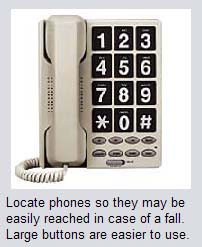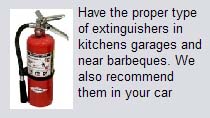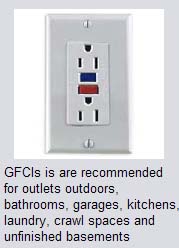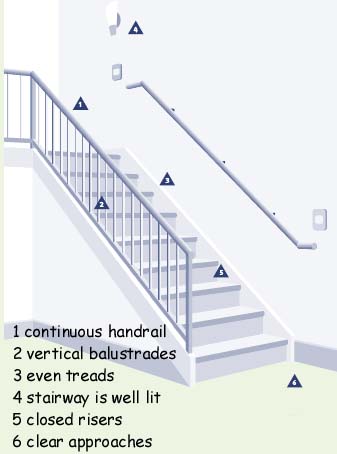As we age our senses are not as sharp and the loss of the sense of vision, smell, hearing and touch can result in injury. With the frequent bone loss of older individuals, the risks from falling are magnified. A simple fall can result in a serious incapacitation injury that can lead to loss of independence. These tips while intended for elderly safety apply to all people, especially children and pets.
 Security
SecurityCheck doors and locks for easy operation and security. All doors should have secure deadbolts that do not require a key from the inside. We recommend 180 degree peepholes at the appropriate height and good porch lighting. You might consider alarm systems for peace of mind.

Phones
Put emergency contact information, doctors, hospitals, pharmacy, etc next to the phone. Make sure the address is listed along with family contact information. Remember that most cordless phones will not work during a power outage, so always have at least one non powered corded phone.
Safety Equipment
Test all smoke alarms, and if they have them, change the batteries on a regular cycle like daylight savings time change. If the residence has
 any combustion appliances (furnace, hot water, fireplace, stove, ect.) or and attached garage we also recommend carbon monoxide detectors. We recommend that you locate any safety equipment your building may have, like fire extinguishers, fire escapes and central alarms. Consider installing extinguishers inside the home and near any barbeques and garages. Read more Fire Safety Tips from the Consumer Product Safety Commission.
any combustion appliances (furnace, hot water, fireplace, stove, ect.) or and attached garage we also recommend carbon monoxide detectors. We recommend that you locate any safety equipment your building may have, like fire extinguishers, fire escapes and central alarms. Consider installing extinguishers inside the home and near any barbeques and garages. Read more Fire Safety Tips from the Consumer Product Safety Commission.Kitchens
Check the lighting assuring that it is adequate to clearly see cooking and working areas. Check location of lighting switches, they should be easily assessible near the doorways. Hot water can severely scald, so assure the water temperature is set no
 higher then 120 degrees. Single conrtol faucets are less likely to cause burns. The flooring should be easily cleaned, not slippery, and any rugs or pads should have non skid backing to help prevent falls. Controls for the range and oven should be in front or beside, not in back where you would have to reach over a burner. All kitchens should have GFCI protected outlets within 6 feet of water. These should be tested regularly to assure they are working. A circuit properly protected by a GFCI can prevent 2/3 of all electrocutions.
higher then 120 degrees. Single conrtol faucets are less likely to cause burns. The flooring should be easily cleaned, not slippery, and any rugs or pads should have non skid backing to help prevent falls. Controls for the range and oven should be in front or beside, not in back where you would have to reach over a burner. All kitchens should have GFCI protected outlets within 6 feet of water. These should be tested regularly to assure they are working. A circuit properly protected by a GFCI can prevent 2/3 of all electrocutions.Halls and Rooms
Inspect all stairs and halls for trip hazards at carpet/flooring edges, thresholds, cords, etc. Look around for sharp edges on furniture, trim, shelving and heaters that could be hazardous in case of a fall. Check for good lighting and switch locations.

Stairs
Since so many injuries occur on stairs, we have dedicated a web page to stair safety. You will find more complete safety info there. Some of the tips include..
1) Continuous handrails:
Consider installing secure hand raills on both sides of steps. They should be at the correct height, easy to grasp and solid construction.
2) Vertical balustrades:
These are to assure there is no opening greater then 4"
3) Even Treads, to prevent trips
4) Good Lighting, with light switches at top and bottom of stairs.
5) Closed risers, these are much less likely to cause a trip.
6) Clear approaches
Read the rest of our stair tips here:
Sources:
Home Safety Checklist for the Elderly
North Carolina State University, North Carolina A&T State University, U.S. Department of Agriculture
Smart Housing Safety and Security Booklet
Department of Housing, GPO Box 690,Brisbane Q 4001

If you find this information useful, don't keep us a secret! List us on any of your favorite networking / bookmarking sites



